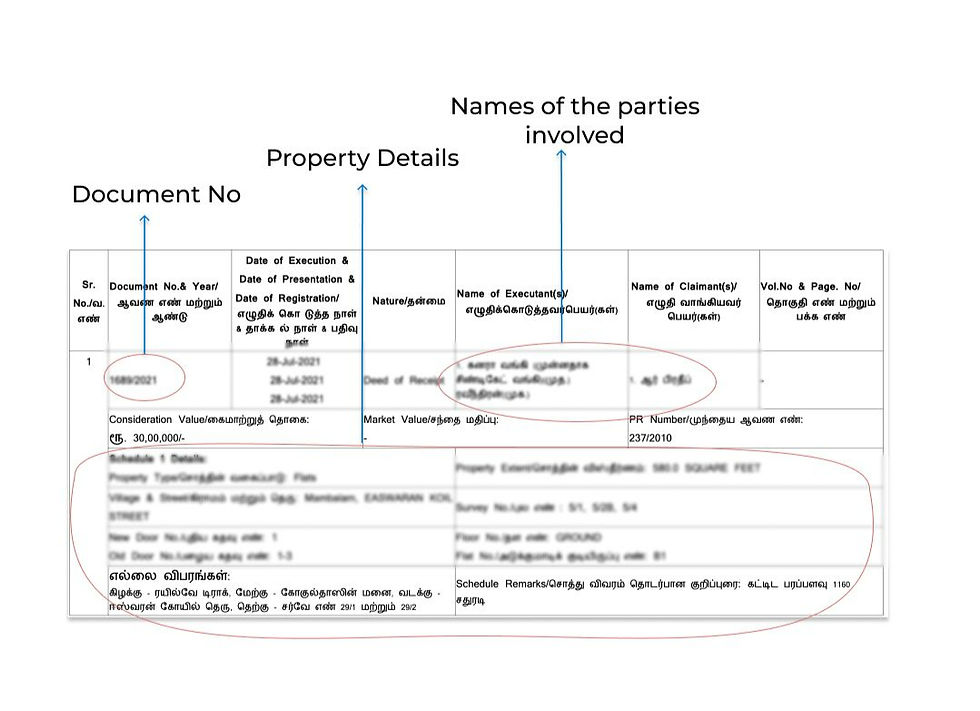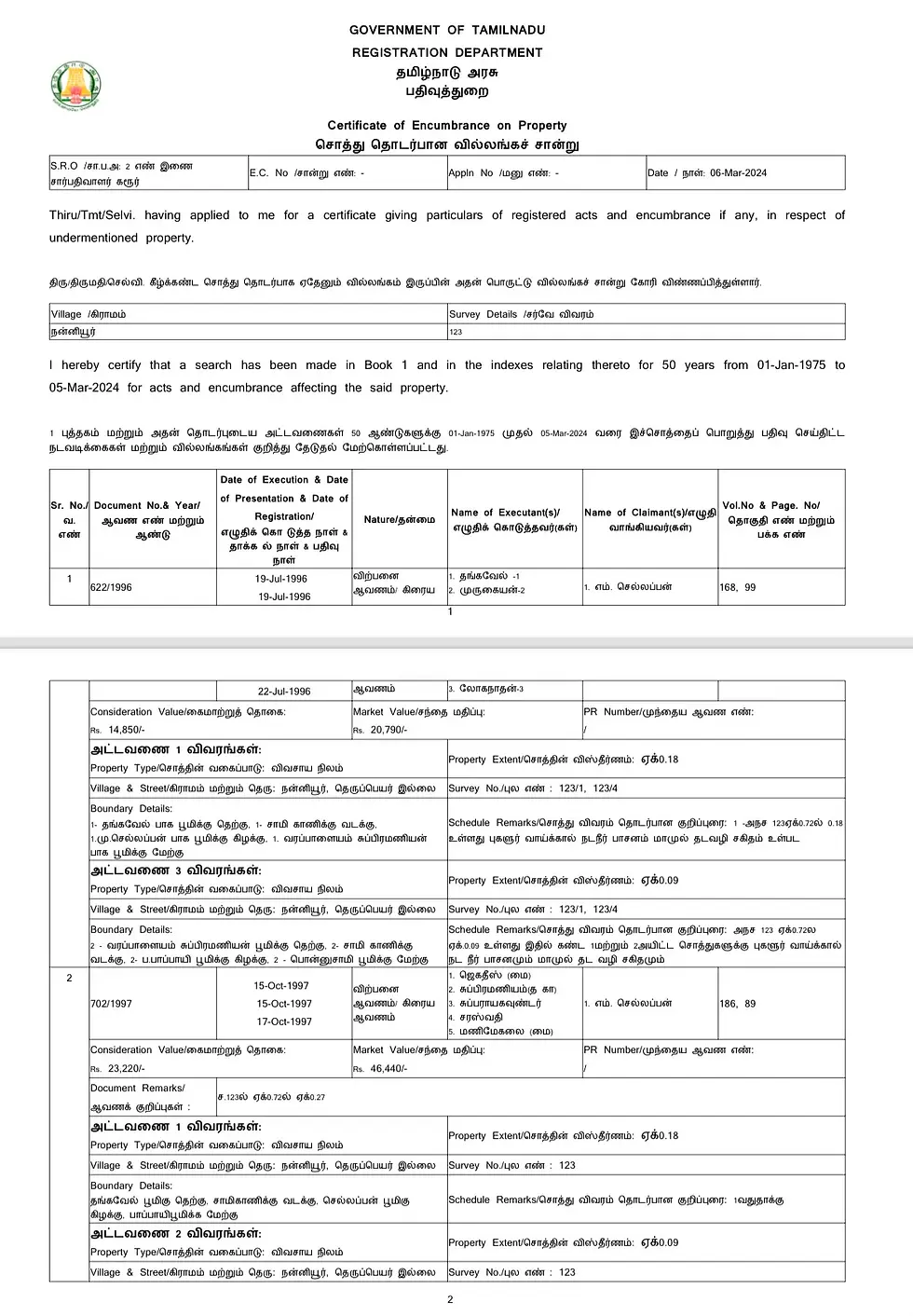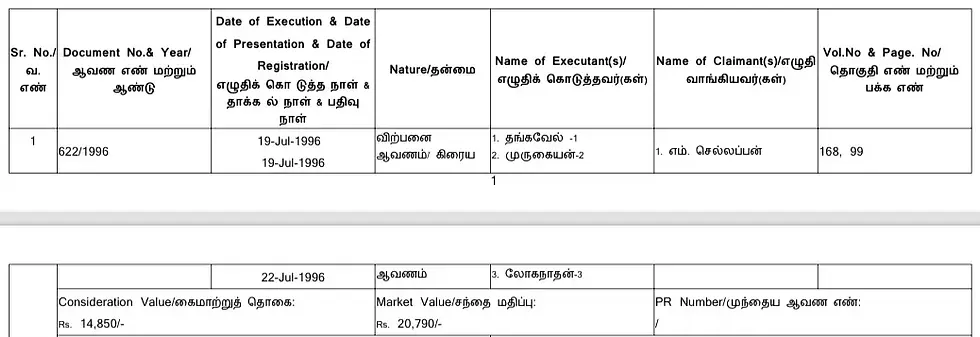What is a Villangam Certificate or Encumbrance Certificate?: A complete guide
- 21ITR067 Mithilesh Menon M
- May 8
- 7 min read

An Encumbrance Certificate (வில்லங்கச் சான்றிதழ்) confirms that a property has a clear title. It is important for buying, selling, or taking loans, and helps settle disputes by showing the property has no legal or financial issues.
Failing to obtain an EC can lead to serious consequences, such as inheriting unresolved debts or legal disputes associated with the property, which could jeopardize your investment and lead to costly legal battles. This underscores the importance of securing an EC in any property transaction.
In this blog, we’ll explain everything you need to know about the Encumbrance Certificate, including what it is, why it matters, and how you can get it.
LIST OF CONTENTS
What is an Encumbrance certificate?
Why do you need an Encumbrance Certificate?
When and Where is an Encumbrance Certificate Needed?
Types of Encumbrance Certificates
How to download Encumbrance Certificate online in Tamil Nadu?
How to Understand Tamil Nadu Encumbrance Certificate?
Encumbrance Certificate vs. Title Deed
EC (Encumbrance Certificate) vs Patta/Chitta
Conclusion
Frequently Asked Questions (FAQs)
What is an Encumbrance certificate?
(வில்லங்கச் சான்றிதழ் என்றால் என்ன?)
An Encumbrance Certificate gives the full history of a property’s registered transactions, like sales and transfers.
In Tamil Nadu, an Encumbrance Certificate is referred to as “வில்லங்கச் சான்றிதழ்" in Tamil, helps check if there are any issues on the property, such as loans, claims, or double registrations.
For now, online Encumbrance Certificates in Tamil Nadu only show records from 1975 onwards. This is because older records were not digitized. To get details about property records before 1975, you need to visit the sub-registrar office.
Why do you need an Encumbrance Certificate?
(ஏன் வில்லங்கச் சான்றிதழ் தேவை?)
Proof of Property Ownership
An Encumbrance Certificate (வில்லங்கச் சான்றிதழ்) shows that the property truly belongs to the seller and is legally in their name.
To Get Property Loans
Banks and financial institutions need the EC to make sure there are no loans or legal issues before giving a loan on the property.
Safe Buying and Selling
The EC is important when buying or selling property, as it proves the property is free from problems like fraud or double ownership.
For Government Schemes
To apply for certain property-related government schemes or benefits, having an EC is required.
When and Where is an Encumbrance Certificate Needed?
An Encumbrance Certificate (EC) is required to prove that a property is free from any legal dues, loans, or disputes. It is an important document in various situations, especially related to property transactions.
When is an Encumbrance Certificate Needed?
When Buying a Property: You need an EC to ensure that the property you’re planning to buy has no pending loans, disputes, or legal claims.
When Applying for a Home Loan: Banks and financial institutions require an EC before approving a home loan. It helps them verify that the property is not already mortgaged or under legal issues.
When Selling a Property: As a seller, you may need to present the EC to prove to the buyer that your property is clear of any debts or legal problems.
During Property Registration or Name Transfer: EC is sometimes needed to register a new sale or transfer ownership from one person to another, especially to prove clear title history.
When Clearing a Loan or Mortgage: Once you repay your home loan, you may be asked to get an EC to show that the mortgage has been officially removed from the records.
For Government Schemes or Subsidies: If you apply for a government housing scheme or land subsidy, authorities might ask for an EC to verify your property status.
Where is an Encumbrance Certificate Needed?
Banks and Financial Institutions: They check the EC before offering loans to ensure the property is not already pledged.
Sub-Registrar's Office: EC is used during registration and verification of a property's legal status and past transactions.
Legal and Property Advisors: Property lawyers and agents use EC to confirm if a property is legally safe to buy or sell.
Government Departments: EC is needed for building approvals, tax assessments, and verifying land ownership in official records.
Real Estate Projects or Housing Boards: Sometimes EC is required for approving applications under housing projects or layout plans.
Types of Encumbrance Certificates
Encumbrance Certificates (EC) are essential legal documents that show whether a property has any financial or legal liabilities. There are two types of Encumbrance Certificates issued based on the Encumbrances during a specific period:
1. Form 15 Encumbrance Certificate
Form 15 is issued when there are Encumbrance in the property during the selected period.
Purpose: It shows that the property has encumbrances (claims or liabilities) during the specified timeframe.
Usage: Buyers, banks, or legal authorities can use this form to review past ownership or financial history before making decisions.
2. Form 16 Encumbrance Certificate (Nil Encumbrance Certificate)
Form 16 is issued when no encumbrances are found for the property during the selected period.
Purpose: It provides assurance to buyers or financial institutions that the property is free from encumbrances.
Usage: Required during property sales, for availing loans, or to confirm clear ownership.
How to download Encumbrance Certificate online in Tamil Nadu?
you can now apply for EC online through the TNREGINET portal maintained by the Tamil Nadu Registration Department.
Steps by Step Process:
Visit the TNREGINET Portal: https://tnreginet.gov.in
Navigate to 'E-Services': Hover over the 'E-Services' tab on the homepage.
Select 'Encumbrance Certificate': Click on 'Encumbrance Certificate' and then choose 'View EC'.
Enter Property Details: Provide necessary details such as Zone, District, Sub-Registrar Office, EC start and end dates, Village, Survey Number, and Subdivision Number.
Submit the Information: After entering the details, click on 'Search'.
View and Download EC: The EC will be displayed on the screen. You can view it online or download it for your records.
Additional Information
Digitally Signed EC: If you require a digitally signed EC for official purposes, you may need to register on the TNREGINET portal and submit an application. This process might involve a nominal fee.
Application Fees: While viewing and downloading the EC is free, applying for a certified copy or a digitally signed EC may incur charges as per the department's fee structure.
How to Understand Tamil Nadu Encumbrance Certificate?
(வில்லங்கச் சான்றிதழை எவ்வாறு புரிந்துகொள்வது?)
The EC contains the following details for a property.

a) Transaction History (பரிவர்த்தனை வரலாறு)
Lists all transactions related to the property for the requested period.

b) Property Description (சொத்தின் விவரம்)
Here you can find the following details about the property:
Type of Property (சொத்தின் வகை): Agriculture (விவசாயம்) or Non-Agriculture (விவசாயமல்லாதது), etc.
Plot No. of the Property (பிளாட் எண்)
Survey No. of the Property (சர்வே எண்)
Extent or Area of the Property (பரப்பளவு)
Boundaries of the Property (எல்லைகள்): Boundaries in each direction – North (வடக்கு), South (தெற்கு), East (கிழக்கு), and West (மேற்கு)
Village/Colony of the Property (கிராமம்/காலனி)

c) Document Number,Year and Date of Execution
(ஆவண எண், ஆண்டு மற்றும் செயல்படுத்திய தேதி)
The details of the deeds associated with a transaction are visible on the ECc. The sub registrar office, book number, document number and year of registration is visible for each entry.
d) Nature of Deed, Market Value, Consideration Value
(பத்திரத்தின் வகை, சந்தை மதிப்பு, பரிசீலனை மதிப்பு)
The nature section in the Encumbrance certificate records the type of transaction and deed.
Release Deed: This deed applies when property claims are released. It is used during succession and in mortgages.
Market Value, also known as guideline value, represents the government's base price for the property. It is used to calculate the stamp duty and registration fees.
Consideration Value is the actual price paid by the buyer for the property.
e) Party Details for each transaction: Executant (EX) & Claimants (CL)
EX- சொத்தை பெறும் அல்லது உரிமை கோரும் நபர் (வாங்குபவர்)
CL- சொத்தை மாற்ற கையெழுத்திடும் நபர் (விற்பவர்)
Note: encumbrance certificate may contain the party's personal details like the name of the party and family member details in some cases

Encumbrance Certificate vs. Title Deed
(வில்லங்கச் சான்றிதழ் மற்றும் தலைப்பு கையெழுத்து ஆவணம் இடையிலான வேறுபாடு)
The Encumbrance Certificate (EC) and Title Deed are both important papers in property deals. But they are used for different reasons and have different legal roles.
Differences and Similarities
Purpose: A Title Deed proves who owns the property. An EC shows if the property has any unpaid loans or legal problems.
Content: A Title Deed gives details such as owner's name, property size, and rights. An EC lists sales, loans, and legal claims made on the property during a certain time.
When Each Document is Used and Why Both Matter
Property Purchase: A Title Deed is needed to transfer ownership from the seller to the buyer. EC helps check that there are no pending loans or legal issues on the property.
Loans: Banks ask for EC to be sure there are no old loans on the property. The Title Deed is needed to use the property as security for the loan.
Legal Disputes: In case of legal problems, both may be needed – EC to show the property’s history, and Title Deed to prove who owns it.
EC (Encumbrance Certificate) vs Patta/Chitta
(வில்லங்கச் சான்றிதழ் மற்றும் பட்டா/சிட்டா இடையிலான வேறுபாடு)
The Encumbrance Certificate (EC) helps confirm that the property has no legal or financial or mortgage issues.
Patta/Chitta, on the other hand, is mainly used for agricultural lands. It contains key information such as the landowner’s name, the type of land, and farming or usage details.
It is always a good practice to download both EC and Patta. checking patta will be useful when many lands are changed from agriculture to non-agriculture. Having both gives the complete background of the property.
Conclusion
In short, an Encumbrance Certificate (EC) is very important in real estate. It shows that a property is free from any legal problems. Whether you are buying, selling, or taking a loan, Always checking the EC helps you uncover hidden issues before making any property decision.
To make sure your property is safe and you can decisions with peace of mind, kindly reachout to us!
Frequently Asked Questions (FAQs)
1. What types of Encumbrance Certificates are there?
Types of EC are Form 15 & Form 16. Refer the above for more clarity.
2. How do I interpret the information in an Encumbrance Certificate?
EC shows financial and legal transactions related to the property, showing any encumbrances or claims that might affect ownership.
3. What should I do if I find discrepancies in the Encumbrance Certificate?
If you find discrepancies in EC, report them to the sub-registrar’s office immediately and provide supporting documents to rectify the issues.
4. Can an Encumbrance Certificate be used as proof of property ownership?
While EC provides a record of transactions, it is not a proof of ownership; the Title Deed serves that purpose.
5. What is the difference between an Encumbrance Certificate and a Title Deed?
EC details the property’s financial and legal history, while Title Deed establishes actual ownership and legal rights to the property.


Comments